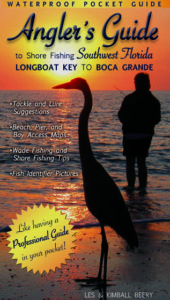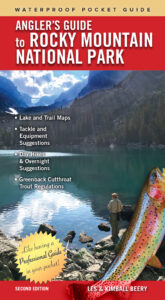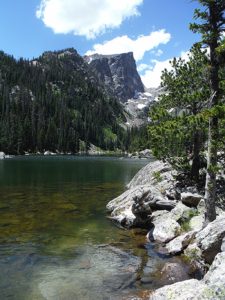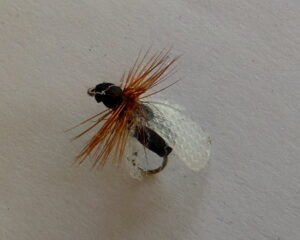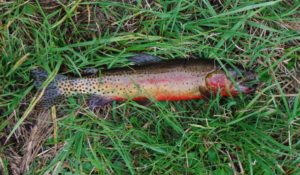Fishing blog: Tales of angling adventures from around the world
Welcome to our fish blog! Here you can read more sage advice from anglers around the world. This is the place for news, tips and non-fiction fish tales from mountain lakes to distant beaches. Please feel free to comment and join in on the conversations and share some fish tales of your own!
Dream Lake is a great choice for your first hike to 9,900 ft. It’s 1.1 miles and 425 ft. up an improved trail from the Bear Lake Parking Lot. It was only stocked once with greenback cutthroat trout in 1997. The trout here usually strike tiny size 20 or 22 flies, but this day a #16 flying ant pattern was in demand. Dream Lake is featured in our new SECOND EDITION of
Years ago, Kimball started a tradition of fishing on New Year’s Day…no matter where she is. My own belief in this “superstition” that became a tradition was limited at first. It took several years before I accompanied her. However, after 50 years of fishing with this amazing lady, it works. She believes that fishing on New Year’s Day and catching something portends another successful year of fishing fun.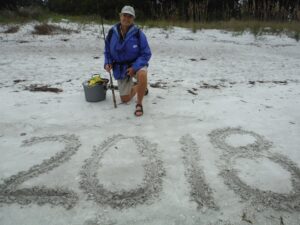
A few years ago, Kim traveled to Colorado for Christmas and I stayed home with our old dog. The weather there was as expected with lows in the mountains at -20⁰F and plenty of snow. Sure enough, on New Year’s Day, she walked down to the Roaring Fork River in Carbondale, CO and there, standing in snow with an air temperature of -10⁰F she caught and released a bunch of big rainbow and brown trout while her fly line froze in the guides.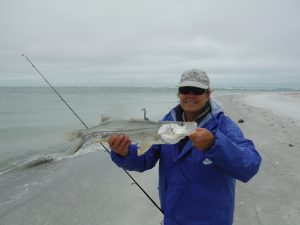
This year, with the weather forecast anything but inviting, we headed north to Sarasota Bay to avoid any red tide in the Manasota Key area and find shelter behind the trees on the north side of Big Pass. Ted Sperling Park, situated on the southern tip of Lido Key, not only features a fine kayak launch but also access to the channel at Big Pass. So, did we hunker down behind the trees and make a few casts? No. We noticed the surf, driven by a 20-mph wind, breaking across the beach to the west and decided to try and survive fishing there. The air temperature never got above 57⁰F, so with the wind chill factored in, it was quite chilly. But, the fish were there!
After trying jigs and shad tail plastics fished slowly along the bottom and fast on top, we put our live shrimp to use. By chin hooking and free lining them with the outgoing tide, using a split shot to help get them down and away from cruising seagulls, Kimball caught and released a couple of nice snook and kept a big sheepshead for dinner. This limited action helped her deal with the cold while I, a true Floridian shivering in the wind, went fishless except for one ladyfish. Kimball and I were the only anglers I saw catch anything all afternoon. A few cups of hot coffee for Kimball, a beer for me and a dozen raw oysters at Phillipe Creek Oyster Bar made a perfect end to the first day of this new year!
The sheepshead went on the grill for a variation of redfish on the half shell. I guess it could be called sheepshead in the whole shell. They’re in the porgy family and have big bones. Fileting results in a lot of wasted meat and scaling a sheepshead is something best done anywhere but in a kitchen. So, as a lazy cook and a fan of grilled fish, I would say this experiment went well. First remove the innards and head then cut the skin like you would to filet it. Sprinkle a little Cajun spice on the inside then lay it on a medium grill for 30 minutes on each side. Unlike a redfish, as it cooks the scales will stand up like fuzz but will stay with the skin and lift off when done. The scales keep the fish from sticking to the grill. The skeleton then lifts cleanly from the meat resulting in a boneless sheepshead on the plate with no mess and minimal waste. We enjoyed Kim’s fish with grilled zucchini and a crab cake, drizzled with home grown calamondin lime juice. Try it, you’ll like it.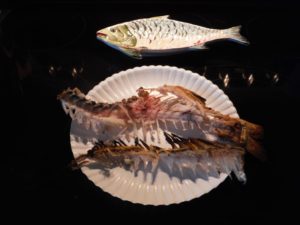
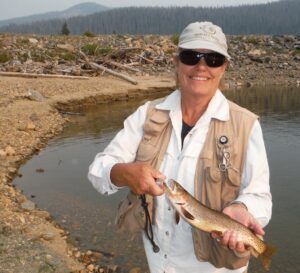
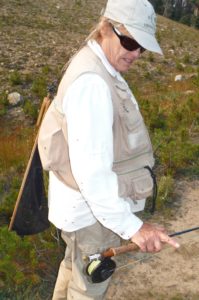
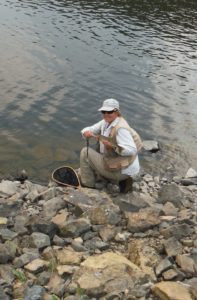
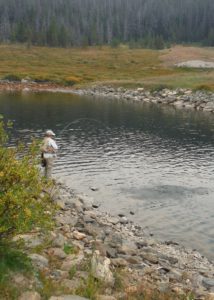 On Labor Day weekend last year, we camped for a few days at Long Draw Reservoir in northern Colorado [10,180 ft.]. The camping was cold but the fishing was hot which led us to take another day trip from Estes Park in our search for big cutthroat trout. We took the short cut down the Big Thompson Canyon and through Masonville to Stove Prairie and up the Poudre from there. So, yesterday [Labor Day] we headed up the Poudre River as apparently every RV in Colorado was coming down.
On Labor Day weekend last year, we camped for a few days at Long Draw Reservoir in northern Colorado [10,180 ft.]. The camping was cold but the fishing was hot which led us to take another day trip from Estes Park in our search for big cutthroat trout. We took the short cut down the Big Thompson Canyon and through Masonville to Stove Prairie and up the Poudre from there. So, yesterday [Labor Day] we headed up the Poudre River as apparently every RV in Colorado was coming down.
We arrived around noon and fished from the dam for 2 hours before a picnic lunch. After lunch, we dropped down below the dam and fished the pool below the cascade from the lake. Both spots held the same big cutthroats we remembered though it seemed there weren’t as many fish wanting to play. Grasshoppers and flying ants were the best flies this trip, just like last year.The biting flies were out in force and not bothered by DEET as they landed…fangs first!
Kimball caught one last cutthroat and we left to enjoy a late dinner at El Burrito restaurant in Ft. Collins on the way home. Their unique chile verde is something everyone that enjoys Mexican cuisine should try. Locals have enjoyed this Godinez family recipe, unchanged, since 1960.
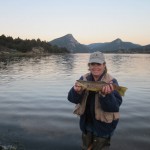
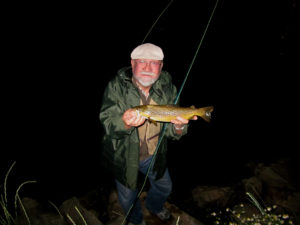 Every year about this time the German brown trout head to the inlet area to begin their pre-spawn party. That means feasting on larger dry flies, especially terrestrials like flying ants, grasshoppers and beetles. We like the area across the bridge from the Fisherman’s Nook parking area. This area is also popular with folks walking on the lakeside trail and elk. Watch out for both. The other hot spot is below the power plant if the turbines are running.
Every year about this time the German brown trout head to the inlet area to begin their pre-spawn party. That means feasting on larger dry flies, especially terrestrials like flying ants, grasshoppers and beetles. We like the area across the bridge from the Fisherman’s Nook parking area. This area is also popular with folks walking on the lakeside trail and elk. Watch out for both. The other hot spot is below the power plant if the turbines are running.
A little riffle on the water helps to hide your leader and tippet but if it is calm, you can still get strikes by going to a longer leader and lighter tippet [10’ total]. We find that a little twitch or skitter seems to draw their attention, no matter what the fly pattern.
There are a lot of smaller stocker size fish along the shoreline but at sunset and later, the larger fish begin to move shallower and mingle with the little ones for the feast. Often these larger fish just sip at flies the little ones get airborne over. Pay close attention…these fish seem to know when you glance away for a second.
Get more local information from our WATERPROOF guide “Angler’s Guide to Rocky Mountain National Park” available at local fly shops, the Nature Conservancy Stores in RMNP, The Chrysalis Gift Shop in the Stanley Hotel, Amazon as a hard copy or digital book, and on our website: www.anglerpocketguides.com. with free shipping
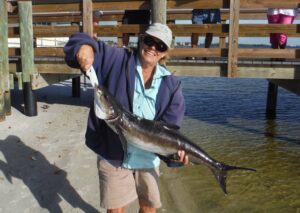 In our continuing search for great fishing away from the troublesome and persistent red tide, we decided to go to the Charlotte Harbor area with a bucket of live shrimp and hit some of our favorite piers. We took two dozen shrimp and only had a short time to fish, so we stayed at each spot for an hour or so.
In our continuing search for great fishing away from the troublesome and persistent red tide, we decided to go to the Charlotte Harbor area with a bucket of live shrimp and hit some of our favorite piers. We took two dozen shrimp and only had a short time to fish, so we stayed at each spot for an hour or so.
We started at the Bay Shore piers. It was low tide and very windy. There were lots of anglers on the pier looking for a break from the wind, but unfortunately, the northwest wind forecast turned into a west wind making for a chilly stop and nothing was biting.
Our next stop was the Laishley Pier in Punta Gorda. We like this pier on an incoming tide and west wind. The rip rap pile east of the pier usually holds trout and snapper so the wind and tide help get the offering out to them. Today though we couldn’t give away a shrimp to any fish and so we left after an hour. Other anglers had the same luck but one did manage a stingray. Hey, anything beats a zero.
From there we went back across the 41 bridge to Port Charlotte to fish and check out the kayak launch at the new Live Oak Point park at the north end of the bridge. The tide was coming in by then and we fished where the current was creating a sand plume next to shore hoping to find a black drum. Les only managed to catch a hard head catfish. So, we left there with three locations and little to show for our efforts. We still had plenty of shrimp and daylight so we headed to the pier at Port Charlotte Beach.
We haven’t been there for a while but in the past had caught trout from the pier and from kayaks. There is a deep grass flat off the south end of the pier. The wind was slacking off, the tide was moving and the water was clear. Kimball rigged a popping cork on 10-pound braid line with 20-pound fluorocarbon leader and a 1/0 octopus hook with a small shrimp. She immediately hooked a large snook that knew exactly what to do by going around a pier piling. That excitement lasted only a few seconds. After re-rigging, she hooked up with a hard head catfish. She had time for a quick release and one more cast before our parking permit expired [expensive overtime ticket…don’t be late].
A powerful strike and long run, at first, suggested a big jack crevalle. After ripping off 50 yards of line, the fish started to circle to the right with another strong run. Our first glimpse of the dorsal fin and tail was definitive of a cobia and a big one at that. A cobia must be 33” long to keep and this one looked to be a keeper. After a couple of more good runs, it swam closer to the pier and the barnacle encrusted pilings. By then, a good crowd had gathered, convinced it was a shark, having never heard of a cobia before. Every time the fish approached the pier we had everyone bang on the rail and stomp on the deck causing the fish to head away again.
Kimball finally beached the fish at the end of the pier after a 30-minute battle. A careful measurement confirmed it was a keeper. We often release fish but a cobia is a rare catch and a favorite of ours, so this one came home. We gutted it, cut it into one inch thick steaks leaving the skin on and then grilled one fresh steak with a mayonnaise glaze seasoned with a little Cajun spice. A hot grill will quickly brown the surface but please DO NOT overcook. The rest of the steaks were packaged and put in the freezer. One taste and we bet you too will find this a favorite. Other names for cobia include ling and lemon fish.